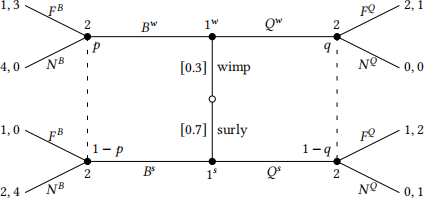Econ 109 – Game Theory – Spring 2022 Problem Set 4
Hello, dear friend, you can consult us at any time if you have any questions, add WeChat: daixieit
Econ 109 – Game Theory – Spring 2022
Problem Set 4
Due by 11:59 pm September 8, 2023
1. In this question, your goal will be to understand whether learning in games is always valuable for players. Consider the following incomplete-information game. First, nature chooses between one of the following two A and B tables, each with probability 0.2:

Then, players 1 and 2 simultaneously choose U or D and L or B, respectively, and obtain payoffs according to the table chosen
by nature. Parts I-III present variations of this game under different assumptions about what players know about nature’s move.
Part I: Suppose no player observes nature’s move (and it is common knowledge).
(a) Represent the game in extensive form.
(b) Represent the game in Bayesian normal form.
(c) Find the unique BNE.
Part II: Suppose only player 1 observes nature’s move (and it is common knowledge).
(d) Represent the game in extensive form.
(e) Represent the game in Bayesian normal form.
(f) Find the unique BNE.
Part III: Suppose both players observe nature’s move (and it is common knowledge).
(g) Represent the game in extensive form.
(h) Represent the game in Bayesian normal form.
(i) Find the unique BNE.
Part IV.
(j) Suppose player 2 does not observe nature’s move. Does player 1 benefit from learning about nature’s move?
Hint: Compare player 1’s BNE expected payoff in (f) to that in (c).
(k) Suppose player 1 observes nature’s move. Does player 2 benefit from learning about nature’s move?
Hint: Compare player 2’s BNE expected payoff in (i) to that in (f).
2. This game is based on the book “Real Men Don’t Eat Quiche” by Bruce Feirstein. There are two players sitting at a bar. The timing is as follows:
i. Nature determines P1’s type as “wimp” or “surly”. P1 observes it, P2 doesn’t. (and this is common knowledge)
ii. P1 chooses whether to order a beer or a quiche.
iii. P2 sitting next to P1, observes P1’s choice. Then P2 decides whether to start a fight with P1 or not.
The extensive form is given below. Let numbers 5 and d denote P2’s conditional beliefs in the two information sets.

(a) [1.5pt] Is there a pooling PBE of this game? YES or NO? (Circle one).
If YES, describe one (and only one): :1 = ,:2 = , 5 = , d = .
Use space below for your argumentation.
(b) Is there a separating PBE of this game? YES or NO? (Circle one).
If YES, describe one (and only one): :1 = ,:2 = , 5 = , d = .
Use space below for your argumentation.
2023-09-11